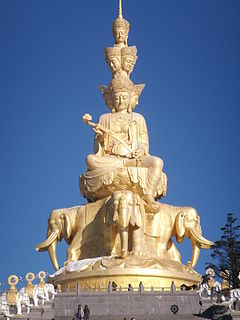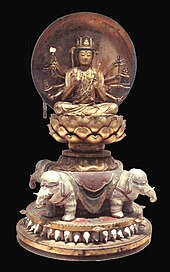Samantabhadra (Bodhisattva)
| Samantabhadra | |
|---|---|
 | |
| Sanskrit | समन्तभद्र
Samantabhadra |
| Chinese | 普賢菩薩 普贤菩萨
(Pinyin: Pǔxián Púsà) (Jyutping: pou2 jin4 pou4 saat3) (Southern Min: Phó͘-hiân Phô͘-sat) |
| Japanese | 普賢菩薩
( romaji: Fugen Bosatsu) |
| Khmer | សមន្តភទ្រ (sa-mun-ta-phoat) |
| Korean | 보현보살
(RR: Bohyeon Bosal) |
| Mongolian | үндэсамбуу Самандабадраа Хамгаар Сайн |
| Tagalog | Samantabhadla (Baybayin: ᜐᜋᜈ᜔ᜆᜊ᜔ᜑᜇ᜔ᜎ) |
| Thai | พระสมันตภัทรโพธิสัตว์ Phra Samantaphat Phothisat |
| Tibetan | ཀུན་ཏུ་བཟང་པོ་ Wylie: kun tu bzang po THL: küntuzangpo |
| Vietnamese | Phổ Hiền Bồ Tát (Chữ Hán: 普賢菩薩) |
| Information | |
| Venerated by | Buddhists |
Samantabhadra (lit. "Universal Worthy", "All Good") is a great
In the
and he is known as Vajramrtra, But this Samantabhadra buddha and Samantabhadra bodhisattva are not the same.In Mahayana sutras
In the Lotus Sūtra, Samantabhadra is described at length in the epilogue, called the Samantabhadra Meditation Sutra (Chinese: 觀普賢菩薩行法經; pinyin: Guān Pǔxián Púsà Xíngfǎ Jīng), with special detail given to visualization of the bodhisattva, and the virtues of devotion to him.[1]
Samantabhadra is also a key figure in the
Ten great vows
The core of Samantabhadra's aspirations in the Bhadracaripraṇidhāna are the ten great vows of Samantabhadra. The ten great vows of Samantabhadra are the following:[3]
- to pay homage to all the buddhas;
- to glorify the qualities of all the tathāgatas;
- to make ample offerings to all the buddhas;
- to confess and repent of all one's misdeeds;
- to rejoice in the merits of others;
- always to request the preaching of the dharma;
- to entreat enlightened beings to remain in the world;
- to always to study the teachings of the buddha;
- to always to respond to sentient beings according to their various needs;
- to dedicate all merits to sentient beings that they may achieve buddhahood.
The ten vows have become a common practice in East Asian Buddhism, particularly the tenth vow, with many Buddhists traditionally dedicating their merit and good works to all beings during Buddhist liturgies.
Mantras and dharani
Like all important bodhisattvas, several mantras are associated with Samantabhadra. One of these is drawn from a work titled Arya-Buddhoshnisha-Cintamani-Mahadharani:[4][5][6]
om̐ samantabhadra sam svāhā
Sam is Samantabhadra's seed syllable. The Dharanisamgraha meanwhile contains the following dharani for Samantabhadra:[7]
om̐ namaḥ samantabhadrāya bodhisattvāya mahāsattvāya || tadyathā || om̐ samantabhadre sarvottama-mahāprāgbhārakalyāṇaṁ samprāpaya hūm̐ phaṭ svāhā ||
Meanwhile the Mahavairocana Sutra contains the following mantra:
namaḥ samantabuddhānāṁ saṁ
In East Asian Buddhism


Unlike his more popular counterpart
Known as Pǔxián in Chinese, Samantabhadra is sometimes shown in
Mahayana esoteric traditions sometimes treat Samantabhadra as one of the 'Primordial' (Sanskrit:
Tibetan Buddhism

In Tibetan Buddhism, Samantabhadra (Tibetan: Kuntuzangpo) is a name that refers to two different beings:[8]
- The ShakyamuniBuddha, i.e. one of the "eight close sons."
- The Primordial Buddha (
Notes
- ^ Katō Bunno, Tamura Yoshirō, Miyasaka Kōjirō, tr. (1975), The Threefold Lotus Sutra : The Sutra of Innumerable Meanings; The Sutra of the Lotus Flower of the Wonderful Law; The Sutra of Meditation on the Bodhisattva Universal Virtue. New York & Tōkyō: Weatherhill & Kōsei Publishing.
- ^ a b Osto, Douglas. A New Translation of the Sanskrit "Bhadracarī" with Introduction and Notes. New Zealand Journal of Asian Studies 12, 2 (December 2010).
- ^ Gimello, Robert M. Ch'eng-kuan on the Hua-yen Trinity 中華佛學學報第 9 期 (pp.341-411):(民國 85年), 臺北:中華佛學研究所,http://www.chibs.edu.tw Chung-Hwa Buddhist Journal, No. 9, (1996) Taipei: Chung-Hwa Institute of Buddhist Studies ISSN: 1017─7132.
- ^ Wylie, A. "On an Ancient Buddhist Inscription at Keu-Yung Kwan, North China." Journal of the Royal Asiatic Society of Great Britain and Ireland, Volume 5 (1871), p. 21. Royal Asiatic Society of Great Britain and Ireland, Cambridge University Press for the Royal Asiatic Society.
- ^ von Schuler, Einar (1989). XXIII. Deutscher Orientalistentag: vom 16. bis 20. September 1985 in Würzburg : ausgewählte Vorträge, Volume 23, F, p. 430. Steiner Verlag Wiesbaden.
- ^ 東洋学報 ("Eastern Studies Journal."), Volumes 66-67, p. 331. 東洋協会調查部 ("Research Department of the Oriental Society"), 1985.
- ^ Hidas, Gergely (2021). Powers of Protection: The Buddhist Tradition of Spells in the Dhāraṇīsaṃgraha Collections, p. 89. Walter de Gruyter GmbH & Co KG.
- ^ Khenchen Thrangu (2019). Tilopa's Wisdom: His Life and Teachings on the Ganges Mahamudra. p. 174. Shambhala Publications.
- ISBN 1-59030-069-6(pbk.: alk. paper). p.xxi
- ^ Rigpa Shedra (October, 2009). Seventeen Tantras. Source: [1] (accessed: Monday April 5, 2010)
References and further reading
- Yeshe De Project (1986). Ancient Tibet: Research materials from the Yeshe De Project. California: Dharma Publishing. ISBN 0-89800-146-3.
- Dudjom Rinpoche; Jikdrel Yeshe Dorje (1991). Translated and edited by Gyurme Dorje with Matthew Kapstein (ed.). The Nyingma School of Tibetan Buddhism: its Fundamentals and History. Vol. Two Volumes. Boston: Wisdom Publications. )
